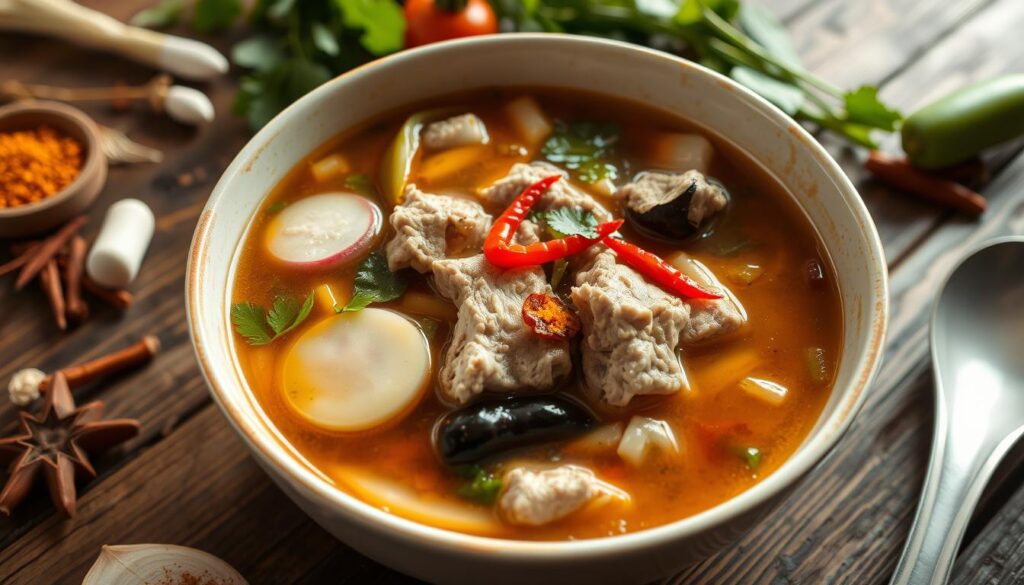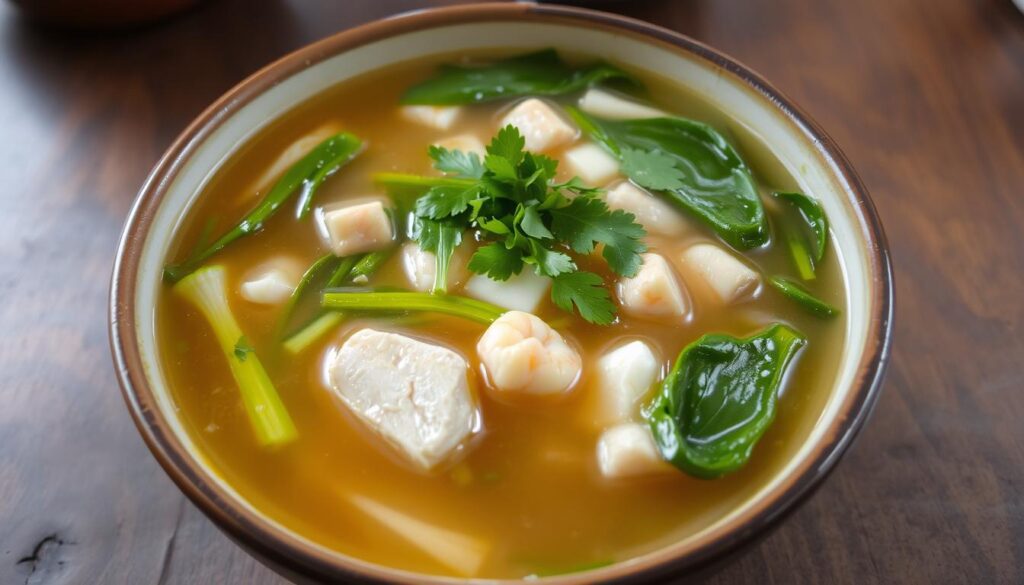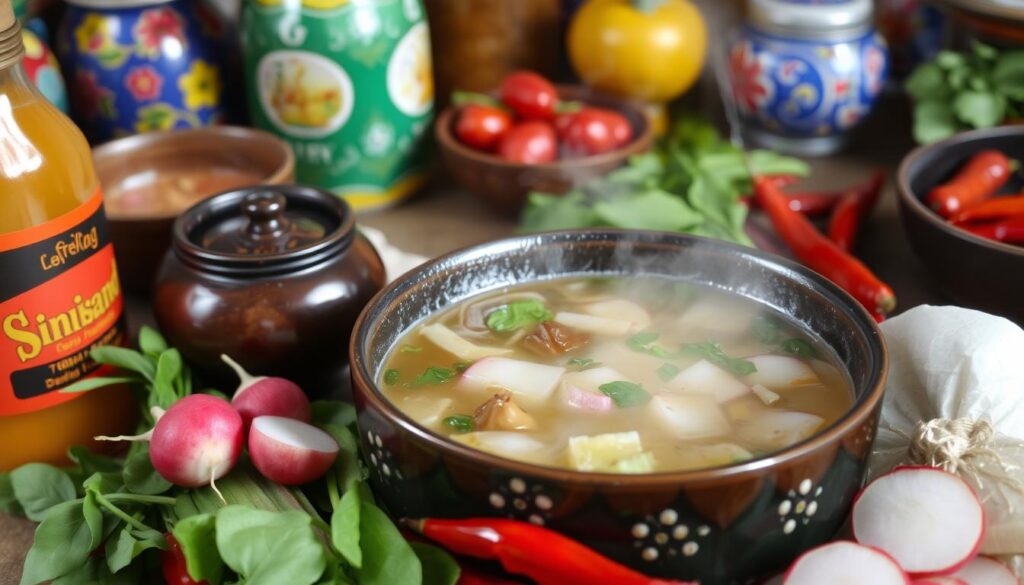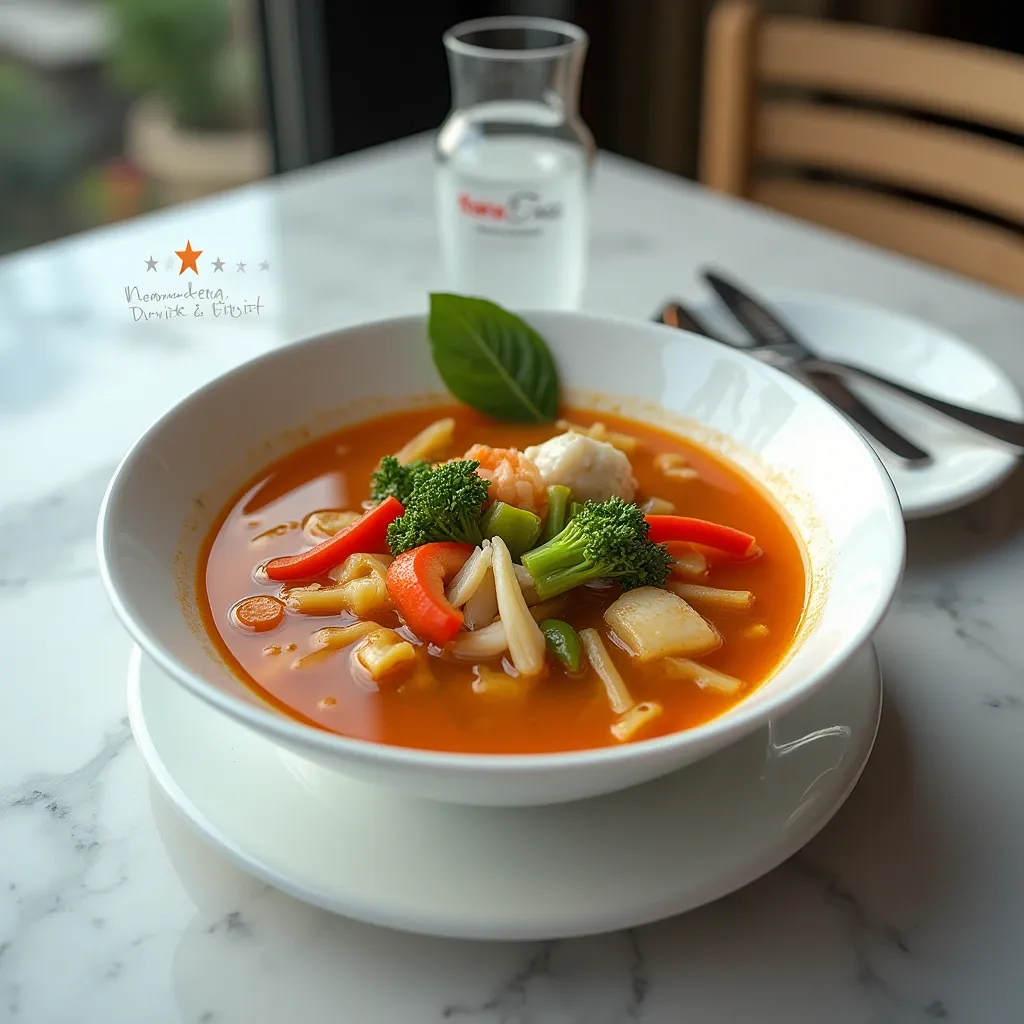Sinigang soup is a key part of Filipino cuisine, loved by many around the world. This article will look at sinigang’s ratings, focusing on its tangy flavors. It shows why it’s a top dish from the Philippines.
In 2021, sinigang got a high rating of 4.63 out of 5 on Taste Atlas. It was named the Best Soup in the World. This honor shows how much the soup connects to Filipino culinary traditions.

Key Takeaways
- Sinigang soup was rated 4.63 out of 5 by Taste Atlas in 2021.
- It gained recognition as the World’s Best Vegetable Soup in 2020 with a rating of 4.8.
- Sinigang na baboy and sinigang na hipon boast impressive ratings, highlighting its appeal.
- The soup’s unique sour flavor makes it a standout representation of Filipino cuisine.
- Celebrated for its importance during special occasions, sinigang remains a staple in Filipino culture.
Introduction to Sinigang Soup
Sinigang is a beloved Filipino soup known for its sour taste, thanks to tamarind, or sampalok. It’s made with proteins like pork, beef, shrimp, and fish. Fresh veggies like water spinach, eggplant, and green beans add to its flavor.
This dish holds a special place in Filipino culture. It’s often served at family meals, bringing everyone together. It’s a symbol of comfort and unity.
The history of sinigang goes back to before the Philippines was colonized. Tamarind is the main ingredient, giving it a tangy taste. This makes sinigang a favorite among many. People also use guava, calamansi, or green mango to make it their own.

Sinigang can also have seafood like prawns, fish, and squid. It’s great for those who prefer seafood. For vegetarians, tofu or mushrooms are used, keeping the sour taste.
Cooking sinigang right is key. Meat is parboiled to make it tender and flavorful. Tamarind is boiled, mashed, and strained to get the best flavor. Adding veggies at the right time is important for a good taste.
Sinigang is more than just a dish; it’s a cultural treasure. It’s celebrated worldwide, even winning awards like the best soup by TasteAtlas. It’s a dish that brings families together and introduces people to Filipino traditions.
What is the rating of sinigang soup?
Sinigang soup has become very popular, earning a high reputation in the food world. Taste Atlas has recognized it as a top Filipino dish. It has won over both local and international food lovers.
Current Rankings in Taste Atlas
In 2021, sinigang scored a 4.63 out of 5 on Taste Atlas. This shows it’s among the world’s best dishes. In 2020, it was named the World’s Best Vegetable Soup with a 4.8-star rating.
Sinigang na baboy, with pork, got a 4.7 rating. Sinigang na hipon (shrimp) scored 4.2 stars. These ratings show the dish’s variety and flavors.
Comparison to Other Famous Dishes
Sinigang stands out when compared to other soups. Romanian ciorbă de fasole cu afumătură scored 4.55 stars. Japanese shoyu ramen got 4.54 stars.
Turkey’s red lentil soup rated 4.53, and Japan’s tonkotsu ramen scored 4.50. Taste Atlas puts sinigang alongside these, showing its growing fame. Its taste and ranking make it a celebrated dish globally.

The Unique Flavor Profile of Sinigang
Sinigang is a traditional Filipino soup known for its unique flavor. The sour taste comes from souring agents, making it special. These ingredients are key to why sinigang is loved in the Philippines and around the world.
Importance of Souring Agents
Souring agents give sinigang its unique taste. Tamarind is the main one, but guava and calamansi are used too. Each adds a special flavor to the soup.
The sourness makes the soup refreshing. It also balances the richness of other ingredients. This makes sinigang a favorite, even in hot weather.
Common Ingredients Used
The ingredients in sinigang make it special. Here are the main ones:
- 2 lb beef shank (or variations like pork belly or spare ribs)
- 1 large bunch of water spinach
- 3 tablespoons of fish sauce
- 15 long green beans
- 2 tomatoes
- 2 Thai chili peppers
- 2 tablespoons vegetable oil
- 1 large red onion
- 1 Japanese eggplant
- ½ lb taro root
- 1 daikon radish
- 15 pods tamarind
These ingredients work well together. The meat and vegetables create a delicious mix. Sinigang’s flavor is a true reflection of Filipino cooking.
Historical Background of Sinigang
Sinigang is a key part of the Filipino culinary tradition. It has deep roots in culture and history. The word “sinigang” comes from “sigang,” meaning “to stew.” This shows the dish’s core.
The sour taste comes mainly from tamarind. This makes sinigang different from other stews that use vinegar. It’s often made in big batches for family gatherings.
Origin of Sinigang in Filipino Culture
Sinigang has its roots in ancient practices. It’s one of the oldest dishes in the Philippines. The soup includes proteins like pork, beef, chicken, and seafood like shrimp and fish.
Different regions in the Philippines have their own recipe variations. They use local fruits like kamias and green mangoes for sourness. This shows how the dish changes with the seasons and local tastes.
The Evolution of Recipe Variations
Over time, sinigang has seen many changes. Each version adds its own flavor with local veggies like okra, taro, and radish. Using fresh ingredients is key to keeping the soup’s true taste.
Sinigang is a dish that crosses cultural lines. It stays popular today, loved by people all over the world.
Global Recognition of Sinigang
Sinigang has made a name for itself in the world of food. This Filipino soup is loved by many around the globe. It’s known for its unique taste, which has earned it a special place in the hearts of food lovers and experts.
Achievements in Food Rankings
Sinigang is recognized as one of the best soups globally. It’s listed in the Taste Atlas as one of the 100 Best Dishes in the World in 2023. This recognition boosts its fame and solidifies its status as a culinary treasure.
Its taste and adaptability have made it a favorite. These qualities contribute to its popularity worldwide.
Acknowledgments from Culinary Experts
Culinary experts often talk about sinigang when discussing traditional soups and comfort foods. They praise its perfect mix of sour, fresh, and savory flavors. This balance is a testament to the skill of Filipino cooking.
Renowned chefs and food critics also appreciate sinigang. They admire its ability to stay relevant today while keeping its heritage alive.
Variations of Sinigang
Sinigang is a favorite Filipino soup known for its variety of flavors and ingredients. It can be made with different meats, including pork, beef, shrimp, and fish. Each adds its own special taste to the soup.
Different Meats Used in Sinigang
Pork belly is often used for its rich flavor. But, other cuts of pork also work well in sinigang. These include:
- Pork shoulder
- Pork butt
- Pork ribs
- Pork neck bones
Beef, shrimp, or fish can also be used, depending on where you are. Each choice gives sinigang a unique flavor, making it loved by many.
Vegetarian and Seafood Versions
Vegetarian sinigang is becoming more popular. It uses tofu and a mix of vegetables like taro, okra, and leafy greens. This version keeps the sinigang taste while being healthier.
Seafood sinigang, like shrimp sinigang, is another option. It uses fresh seafood and keeps the sinigang flavor.
| Type of Meat | Flavor Profile | Common Variations |
|---|---|---|
| Pork | Rich and savory | Sinigáng na baboy, Sinigáng sa misô |
| Beef | Hearty and robust | Cansi, Sinanglaw |
| Shrimp | Light and fresh | Sinigang na hipon |
| Fish | Mild and delicate | Sinigang na isda |
| Vegetarian | Earthy and wholesome | Vegetarian Sinigang |
These variations make sinigang a dish for all occasions. It’s perfect for any taste, ensuring a great meal for everyone.
Cooking Techniques for the Perfect Sinigang
To make perfect sinigang, knowing cooking techniques is key. Traditional methods simmer ingredients for hours. This slow cooking blends flavors well.
Modern methods, like pressure cookers and slow cookers, save time. They make meat tender without losing flavor.
Traditional Methods vs. Modern Approaches
Traditional sinigang takes patience and consistency. Raw ingredients, like pork spare ribs, are seared first. Then, simmering with onions and tomatoes for 45 minutes extracts flavors fully.
Modern techniques are quicker but just as tasty. Each method has its own charm, fitting different cooking styles.
Importance of Fresh Ingredients
Fresh ingredients are essential in sinigang. Ingredients like tender pork and ripe tomatoes greatly affect the taste. Fresh veggies like bok choy and long beans add texture and nutrition.
The vibrant, wholesome ingredients keep sinigang’s renowned taste alive. They delight those who enjoy it.
Popularity of Sinigang Among Foodies
Sinigang has become a favorite dish among food lovers worldwide. Its tangy flavor attracts many, making it a hit in Filipino restaurants globally. The way it’s made in these places has boosted its popularity.
Filipino Restaurants Promoting Sinigang
Many Filipino restaurants highlight sinigang on their menus. Places like Locavore Kitchen & Drinks, Romulo Cafe, and SENTRO 1771 are known for their sinigang. Taste Atlas has also praised six local restaurants for their sinigang, showing its importance.
Dish Ratings and Reviews
Reviews have made sinigang even more famous, with a 4.63 rating in 2021. It was once named the World’s Best Vegetable Soup in 2020, with a 4.8 rating. Sinigang na baboy scored 4.7, and sinigang na hipon got 4.2. These ratings show sinigang’s lasting appeal and its top spot in global culinary rankings.
| Dish | Rating | Rank |
|---|---|---|
| Sinigang | 4.63 | 1st (Best Soup in the World) |
| Sinigang na baboy | 4.7 | N/A |
| Sinigang na hipon | 4.2 | N/A |
| Lechon | 4.4 | 3rd |
| Lechon Kawali | 4.3 | 8th |
| Adobo | 4.2 | 10th |
Health Benefits of Sinigang Soup
Sinigang soup is more than just a comforting dish. It’s packed with health benefits. This traditional Filipino soup has a mix of ingredients that boost its nutritional value. It includes meats or seafood, fresh veggies, and a souring agent that adds flavor and nutrition.
Nutritional Components
Sinigang is rich in vitamins and minerals, providing many health benefits. It has:
- Vitamins A and C from tomatoes, eggplant, and water spinach
- Potasium and magnesium for heart health
- Protein from pork, shrimp, or fish
One serving of pork sinigang has 150-200 calories. It gives a good amount of vitamins and minerals. This makes it great for improving your diet.
Comfort and Relief Provided by Sinigang
The warm, tangy taste of sinigang is a joy for the taste buds. It’s a comfort food for many, perfect for cold weather or when you’re not feeling well. The hot soup and antioxidants in tamarind offer relief for both body and mind.
Sinigang also helps with digestion and fights off colds or flu. It’s a favorite at family gatherings, making it a key part of Filipino culture.
Sinigang Soup in Filipino Celebrations
Sinigang soup is a big deal in Filipino celebrations. It stands for unity and warmth during important times. This dish is a hit at family gatherings, whether it’s a regular meal or a big celebration.
Its tangy taste and cozy feel make it a top pick for family events. Relatives love to come together and enjoy sinigang as they celebrate life’s big moments.
Role in Family Gatherings
In Filipino culture, meals are a big part of family time. Sinigang is key to this tradition. It brings everyone together, filling the air with joy and connection.
At reunions, birthdays, and other big events, sinigang is a must. It shows the value of family and our shared love for food.
Significance During Holidays
During holidays, sinigang is more than just a meal. It’s a big part of the celebration. It shows our hospitality and tradition.
Many families add sinigang to their holiday menus. This includes Christmas, New Year’s, and Easter. Sharing this soup makes the holiday even more special. It helps families make lasting memories together.
| Celebration | Typical Dishes | Sinigang’s Role |
|---|---|---|
| Christmas | Lechon, Bibingka | Essential part of the feast |
| New Year’s | Various Meat Dishes | Symbolizes prosperity and warmth |
| Weddings | Adobo, Kare-Kare | Fosters family bonding |
Tips for Making the Best Sinigang at Home
Making sinigang at home requires finding the perfect balance of flavors. This Filipino dish is known for its sour taste and variety of ingredients. By following some key tips, you can improve your sinigang and avoid common mistakes.
Common Mistakes to Avoid
Many home cooks struggle with sinigang. Here are some mistakes to steer clear of:
- Overcooking vegetables, which can make them mushy and lose flavor.
- Not using enough souring agents like tamarind or tomatoes, which are key for the tangy taste.
- Not simmering slowly enough, as this process makes the meat tender and the flavors richer.
- Not skimming off impurities from the broth, which can cloud the soup and change its taste.
Recommended Cooking Equipment
The right tools are key for making sinigang. Here are some essential items:
- A heavy pot or Dutch oven for slow simmering, ensuring even heat distribution.
- A cutting board and sharp knife for chopping vegetables and proteins efficiently.
- A ladle for serving the soup, ideally with a long handle for easy access.
- A blender for those who prefer a smoother broth, though traditional versions usually keep the texture chunky.
Conclusion
Sinigang is more than just a soup; it’s a key part of Filipino culture. Its tangy taste comes from souring agents like tamarind. This makes it a dish loved for centuries.
It shows off the Philippines’ rich flavors and holds cultural value. Sinigang is often enjoyed at family gatherings and celebrations.
It’s ranked as the world’s best vegetable soup by TasteAtlas. It’s also featured in many food blogs, gaining fans worldwide. This summary highlights its adaptability, from pork to seafood and vegetarian options.
Its growing fame in food circles shows its importance. It’s a dish that’s sure to be loved for years to come.
Learning about sinigang’s history and health benefits reveals its true value. It’s not just a meal; it’s a way to connect with Filipino culture and tradition.
FAQ
What is sinigang soup?
Sinigang is a traditional Filipino soup known for its sour taste. It comes from tamarind. It has proteins like pork, beef, shrimp, or fish, and fresh veggies like water spinach, eggplant, and green beans.
How is sinigang usually prepared?
Sinigang is simmered to get the best flavors. You can also use pressure cookers or slow cookers for ease. But, fresh ingredients are key for real taste.
What makes sinigang so popular?
Its tangy flavor, cultural importance, and health benefits make it loved by many. It’s a comforting dish enjoyed by families and friends.
Can sinigang be made vegetarian?
Yes, sinigang can be made without meat. It uses tofu and various veggies, keeping the rich flavors. This version is great for those on plant-based diets.
What are the health benefits of sinigang?
Sinigang is full of vitamins and minerals from fresh veggies. Water spinach and tomatoes add nutrients. It’s also seen as comforting, helping with colds.
What is the current rating of sinigang according to Taste Atlas?
In 2024, sinigang ranked 17th in the world’s best soups, with a 4.5-star rating. Sinigang na baboy (pork sinigang) ranked 38th with a 4.4-star rating.
What variations of sinigang exist?
Sinigang can have different meats like pork, beef, shrimp, or fish. Each adds its own flavor. There are also vegetarian and seafood versions for different tastes.
How is sinigang significant in Filipino culture?
Sinigang is a key dish in Filipino cuisine. It’s served at family reunions and festive times. It symbolizes unity and warmth as families come together to eat.
What common mistakes should be avoided when making sinigang?
Avoid overcooking veggies, which can ruin the texture. Also, don’t skimp on souring agents. They’re key for the classic tangy flavor of sinigang.
Why is it important to use fresh ingredients in sinigang?
Fresh ingredients are vital for sinigang’s authentic taste. The quality of ingredients greatly impacts the flavor and overall dish experience.

